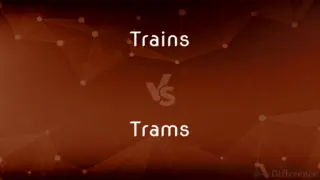LAN vs. Ethernet — What's the Difference?
By Tayyaba Rehman — Updated on November 6, 2023
LAN (Local Area Network) is a network covering a small geographic area, like a home or office; Ethernet is a technology that connects devices within a LAN.

Difference Between LAN and Ethernet
Table of Contents
ADVERTISEMENT
Key Differences
A Local Area Network (LAN) is a network that connects computers and devices in a limited geographical area such as a home, school, computer laboratory, or office building. Ethernet, on the other hand, is a specific networking technology used to transmit data over a LAN. It is defined by a set of standards and protocols for network communications.
While LAN is a broad term that refers to the interconnection of a group of computers in a limited area, Ethernet describes how data is actually transmitted across this network. Ethernet uses protocols from the IEEE 802.3 standard for communication, ensuring devices can communicate efficiently. LANs can use Ethernet as their transmission method, but they can also use other technologies such as Wi-Fi or token ring.
Every LAN is characterized by its smaller geographic range and is typically confined to a single building or a group of buildings. Ethernet is used within many LANs due to its speed, reliability, and the fact that it’s well-standardized, making it a common choice for network administrators. LANs facilitate the sharing of resources, data, and applications, and Ethernet is a vehicle that often drives this digital traffic.
Though Ethernet is a common way to implement a LAN, it is not the only way. A LAN can be set up with various technologies including Wi-Fi, while Ethernet networks can extend beyond a traditional LAN setup using technologies like Metro Ethernet, which can connect multiple LANs across a metropolitan area. Despite these variations, Ethernet remains synonymous with wired LAN networks due to its widespread adoption and historical significance.
Comparison Chart
Definition
Network in a small geographical area.
Technology for networking devices.
ADVERTISEMENT
Scope
Can be wired or wireless.
Primarily wired technology.
Usage
Connects devices for data sharing.
Transmits data between connected devices.
Standards
Can use various protocols.
Uses IEEE 802.3 standards.
Implementation
Can use Ethernet, Wi-Fi, etc.
Implemented within LANs.
Compare with Definitions
Lan
Network within a limited area.
The office computers are connected via a LAN.
Ethernet
Standard for LAN data transfer.
Ethernet cables are running through the entire building.
Lan
Interconnected group of computers.
Our LAN allows for quick file sharing.
Ethernet
Protocol for network communication.
The Ethernet connection ensures high-speed access.
Lan
Local network setup.
They installed a LAN to facilitate in-house communication.
Ethernet
Cable-based networking system.
We upgraded to gigabit Ethernet for faster data transmission.
Lan
Small-scale computer network.
The LAN in the library supports student research.
Ethernet
Wired network technology.
Our office uses Ethernet to connect all workstations.
Lan
Intra-office communication network.
The LAN crashed, disabling all internal emails.
Ethernet
IEEE 802.3 standard networking.
Ethernet is favored for its stability and speed.
Lan
A system that links together electronic office equipment, such as computers and printers, and forms a network within an office, building, or group of buildings
Ethernet
Ethernet () is a family of wired computer networking technologies commonly used in local area networks (LAN), metropolitan area networks (MAN) and wide area networks (WAN). It was commercially introduced in 1980 and first standardized in 1983 as IEEE 802.3.
Lan
A local area network; a network{3} connecting computers and word processors and other electronic office equipment within a small area, to create an inter-office system, typically within one building or one site of a corporation. Contrasted to WAN, a wide-area network.
Ethernet
Alternative case form of Ethernet
Lan
A local computer network for communication between computers; especially a network connecting computers and word processors and other electronic office equipment to create a communication system between offices
Ethernet
A type of networking technology for local area networks; coaxial cable carries radio frequency signals between computers at a rate of 10 megabits per second
Common Curiosities
What is Ethernet?
Ethernet is a technology for connecting devices within a LAN.
What is a LAN?
A LAN is a network that covers a small geographic area like an office.
Is Ethernet used outside of LANs?
Ethernet is primarily used within LANs but can be extended with technologies like Metro Ethernet.
What cables are used in Ethernet?
Ethernet typically uses twisted-pair or fiber optic cables.
Can a LAN be wireless?
Yes, LANs can be either wired or wireless.
How does Ethernet work?
Ethernet transmits data packets based on the IEEE 802.3 standard.
Can LANs connect buildings?
Yes, if the buildings are close enough or through technologies like Metro Ethernet.
Can Ethernet support high speeds?
Yes, Ethernet can support very high speeds, especially with gigabit Ethernet.
Do all LANs use Ethernet?
No, some LANs may use Wi-Fi or other networking technologies.
Are LANs secure?
LANs can be very secure, depending on the network configurations.
Is Ethernet still evolving?
Yes, Ethernet technology continues to evolve with faster standards.
Is Ethernet reliable?
Ethernet is known for its reliability and speed in data transmission.
How do you set up a LAN?
A LAN setup involves network planning, cabling, and configuring devices.
Can Ethernet be wireless?
No, Ethernet is inherently a wired technology, while wireless alternatives exist.
How are LANs typically used?
LANs are used for sharing resources and data within a limited area.
Share Your Discovery

Previous Comparison
Mediocrity vs. Mediocre
Next Comparison
LCD vs. HDTVAuthor Spotlight
Written by
Tayyaba RehmanTayyaba Rehman is a distinguished writer, currently serving as a primary contributor to askdifference.com. As a researcher in semantics and etymology, Tayyaba's passion for the complexity of languages and their distinctions has found a perfect home on the platform. Tayyaba delves into the intricacies of language, distinguishing between commonly confused words and phrases, thereby providing clarity for readers worldwide.















































